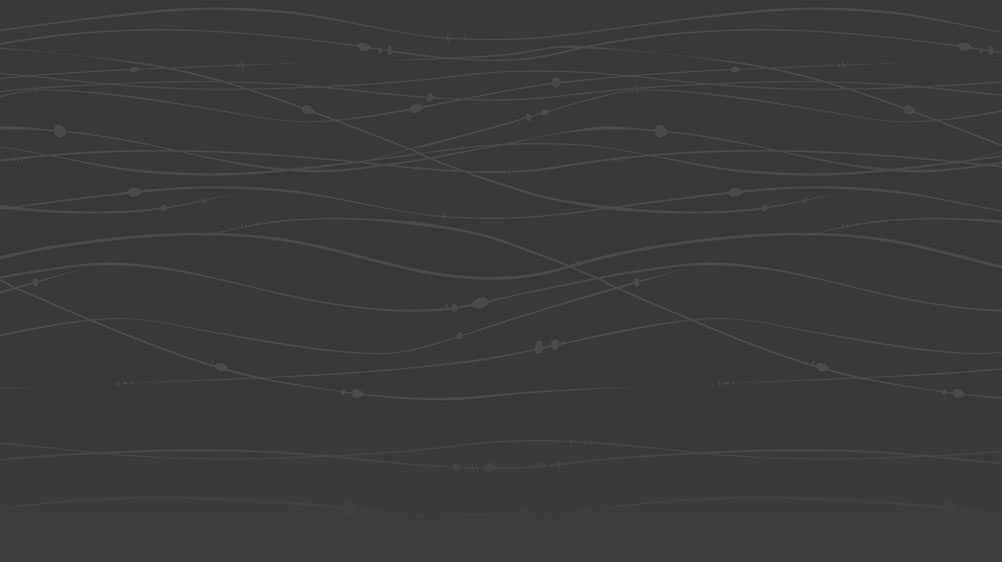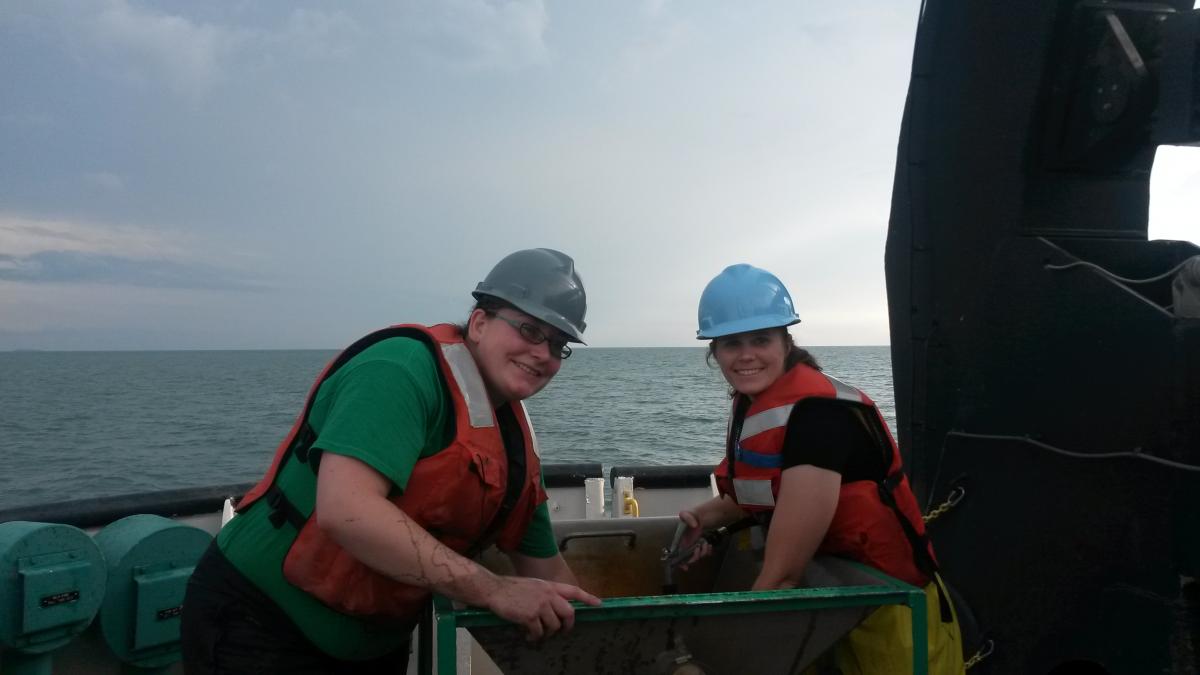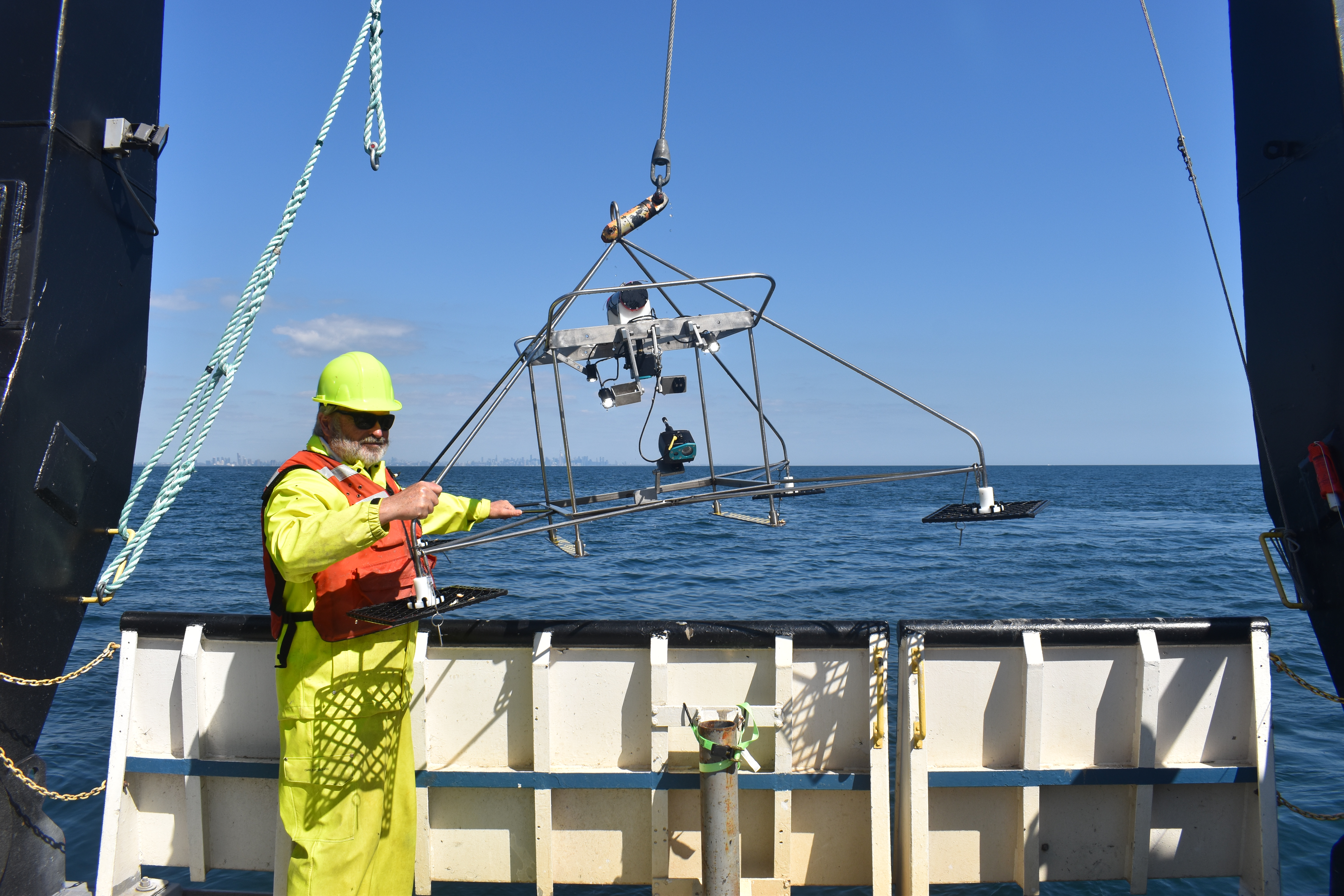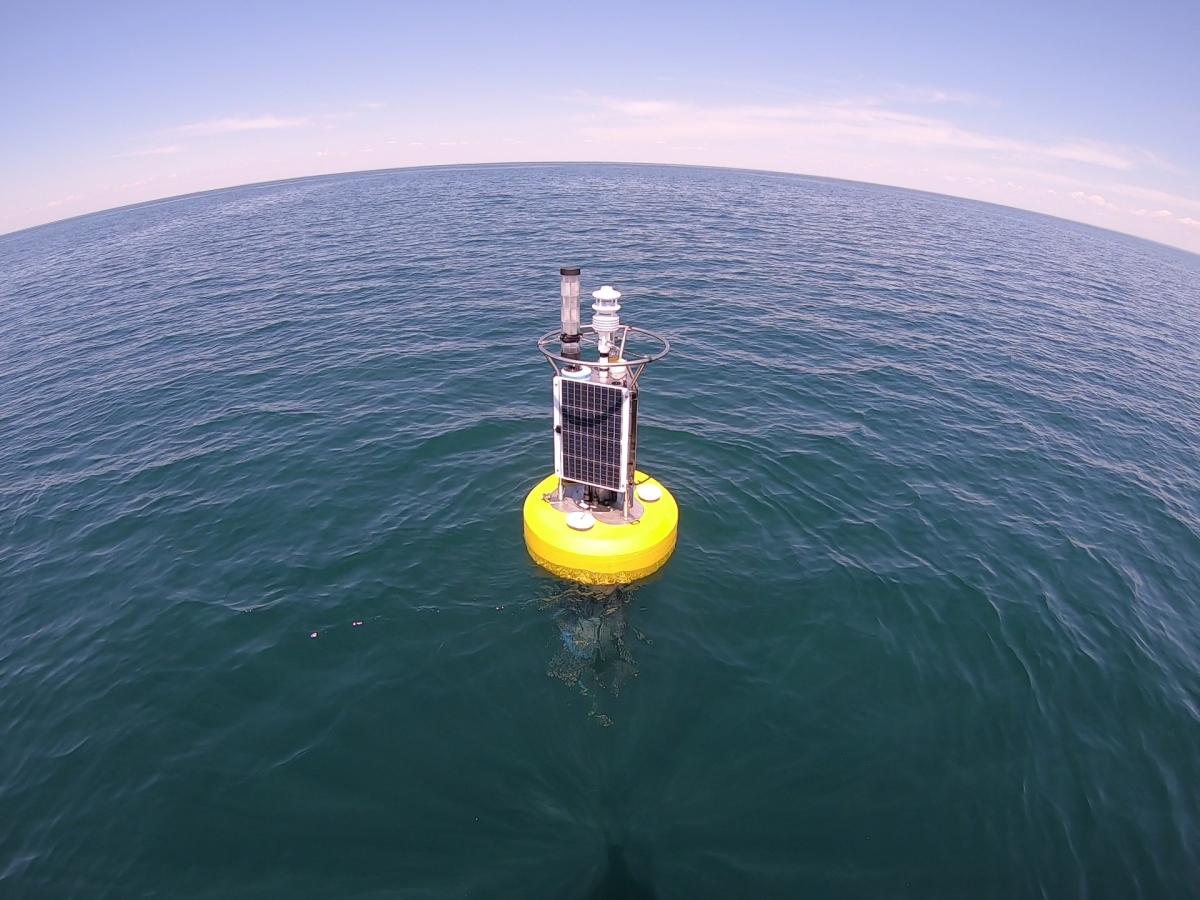
Research at the Great Lakes Center focuses on the ecology and ecosystems of the Great Lakes and their tributaries. GLC research scientists, affiliates at Buffalo State University, and collaborators from other institutions bring diverse areas of expertise to the Great Lakes. Such expertise enables scientists to provide policymakers with information, which in turn promotes more informed decisions about ways to protect water quality, support the survival of native species, manage nuisance invasive species, monitor carcinogens in the food web, and many more. Research also contributes to scientific understanding of the complex interactions that occur in aquatic ecosystems around the world.
Much of the research done by GLC scientists is carried out from the Field Station and focuses on aquatic ecology and ecosystems. This includes large multi-agency studies of Lake Erie as well as graduate and undergraduate research projects.
The Great Lakes Center has several monitoring efforts ranging from a continuously monitoring buoy to an intensive benthic sampling cruise that spans all five Great Lakes.
Some of our research focuses on conservation of threatened freshwater species. Sasha Karatayev and Lyubov Burlakova are working on projects aimed at identifying threatened populations and genetic diversity of native freshwater mussels in Texas. We also completed a project aimed at understanding the habitat use and feeding ecology of the lake sturgeon in the Lower Niagara River.
The Great Lakes Center conducts research to study the effects of species that have already invaded the Great Lakes and their tributaries, as well as to identify species which have the potential to invade. Species of interest include zebra and quagga mussels and their parasites, round gobies, alewives, and Hemimysis anomala.
 The EPA Great Lakes National Program Office (GLNPO) Biology Monitoring Program is designed to provide managers access to biological data on zooplankton and benthos to support decision-making. In collaboration with Cornell University, we collect benthos (Buffalo State), zooplankton, and chlorophyll data (Cornell University) across the five Great Lakes, analyze this data, and make it available to environmental and fisheries managers. In addition to an annual survey of 57 long-term stations, a much more detailed survey is conducted on each lake every 5 years with the Coordinated Science and Monitoring Initiative (CSMI). We participated in CSMI surveys in 2014 (Lake Erie), 2015 (Lake Michigan), 2016 (Lake Superior), 2017 (Lake Huron), 2018 (Lake Ontario), 2019 (Lake Erie), 2021 (Lake Michigan), 2022 (Lake Huron and Lake Superior), and 2023 (Lake Ontario). Additional research projects include impact of dreissenids on the lower food web and benthic nepheloid layer, and development of remote sensing methods.
The EPA Great Lakes National Program Office (GLNPO) Biology Monitoring Program is designed to provide managers access to biological data on zooplankton and benthos to support decision-making. In collaboration with Cornell University, we collect benthos (Buffalo State), zooplankton, and chlorophyll data (Cornell University) across the five Great Lakes, analyze this data, and make it available to environmental and fisheries managers. In addition to an annual survey of 57 long-term stations, a much more detailed survey is conducted on each lake every 5 years with the Coordinated Science and Monitoring Initiative (CSMI). We participated in CSMI surveys in 2014 (Lake Erie), 2015 (Lake Michigan), 2016 (Lake Superior), 2017 (Lake Huron), 2018 (Lake Ontario), 2019 (Lake Erie), 2021 (Lake Michigan), 2022 (Lake Huron and Lake Superior), and 2023 (Lake Ontario). Additional research projects include impact of dreissenids on the lower food web and benthic nepheloid layer, and development of remote sensing methods.
We identified benthic samples collected onboard the EPA R/V Lake Guardian from all the Great Lakes in 2012–2023 and submitted the data to GLNPO. These data are the basis for individual lake reports as well as reports for the State of the Great Lakes. Thus far, the results of the study have been published in over 30 papers, 13 reports, and were presented at regional and international meetings.
Seventeen years of GLNPO Biology Monitoring Program benthic data were analyzed by Burlakova et al. (Burlakova et al., 2018) to reveal temporal and spatial trends in benthic community structure across the lakes. In 2018, we published a Special Issue containing 18 papers in the Journal of Great Lake Research (“U.S. EPA GLNPO Long-Term Monitoring of the Laurentian Great Lakes: Approaches, achievements and lessons learned,” Eds. Burlakova, L., A. Karatayev, L. Rudstam, and E. Hinchey). Some of the publications and reports of the 2014-2021 CSMI benthic surveys are available on the Publications page.
Check out this video of a nighttime ponar grab, taken during August 2013 while our researchers were aboard the R/V Lake Guardian. (Video credit: US EPA.)
Photo galleries: Monitoring Great Lakes benthos from the R/V Lake Guardian 2013, Great Lakes Benthos Monitoring 2016, CSMI Lake Huron 2017, CSMI Lake Ontario 2018, GLC Alternative Work Plan 2021
News articles: Newsletter #21: GLC samples Great Lakes amid challenging weather, Newsletter #21: CSMI Lake Huron survey on Canadian boat, Newsletter #22: That’s a wrap: Intensive survey of Lake Superior completed, Newsletter #23: Sampling Hamilton Harbor, Newsletter #23: Another year collected, Newsletter #23: Benthic Palooza in Lake Ontario
Using the data and images from the EPA Long-term Biological Monitoring Program, CSMI, and DNA Barcode Reference Library project, we are creating a digital reference guide to the benthic species found in the Great Lakes.

News articles: Great Lakes Center, EPA Collaborate on New Imaging Tool; Great Lakes Restoration: "New method for rapid assessment of quagga and zebra mussel populations"
Images from side-looking Benthic Imaging System (BIS) cameras used for rapid assessment of dreissenid populations during CSMI surveys are also used to assess spatial distribution of benthos and Mysis. Communities of benthic macroinvertebrates are among the most useful indicators for biological assessment of environmental and anthropogenic stressors, but both sample processing and species identification are time-intensive, often requiring several years to identify all samples from a large-scale survey. Mapping benthic landscape or “benthoscape” structure and dynamics using underwater video can provide valuable and cost-effective assessment of bottom habitats on large spatial scales with minimal habitat disturbance.
In 2019, during the CSMI benthic survey in Lake Erie, we used this approach to characterize benthic habitats, and then tested whether visual classification could serve as an indicator of hypoxia (Burlakova et al., 2023). We identified four habitat types that differed significantly in near-bottom dissolved oxygen concentration and confirmed that video analysis can provide a quick and reliable method to detect habitats affected by periodic hypoxia. Video identification of benthoscapes may be important for regional monitoring of over 20 hypoxic zones documented in the Great Lakes where the extent and magnitude of hypoxia currently represent a major knowledge gap. We used this method to detect hypoxic habitats in 2022 on Saginaw Bay of Lake Huron, , and in 2023 on Hamilton Bay of Lake Ontario. The results of this study are being prepared for a peer-review publication.
Over 110 lake-wide benthic surveys were conducted on the Laurentian Great Lakes since 1929. However, these studies often are not readily available, and have never been combined in one dataset to preserve historic data. According to our estimations, primary data for at least 20% of all surveys are incomplete or have already been lost. For over four years, the Great Lakes Center has been conducting an inventory of benthic surveys for all the Great Lakes to create a database with all the available information on species composition, distribution, density, and biomass of benthic invertebrates. Considering the rarity of long-term benthic studies in lake ecosystems, this data set could be useful to explore effects of different environmental factors and exotic species on community organization, and for monitoring of water quality, biodiversity, exotic species introduction, fish food base assessment, and other ecosystem services provided by benthic community. Our first complete dataset on the Lake Ontario benthic community includes taxonomic data to the species level for 11 of the surveys and data to the group level for another two surveys covering the last 54 years, and was published as a data paper in Ecology (Burlakova et al., 2022). Our second paper summarizing 90 years of benthic research in Lake Erie has been recently published in the Journal of Great Lakes Research and the database in Ecology as a data paper. Currently we are summarizing benthic research conducted in Lakes Superior and Huron.
Benthic nepheloid layers (BNLs) are areas of high turbidity and suspended solids that form near the benthos during summer stratification. BNLs can be several meters thick and are common in the Great Lakes. The suspended sediment and other material that build BNLs can come from a variety of sources, including sediment resuspension, entrainment of spring runoff in the hypolimnion, settling of particles from the epilimnion, and from density currents. We analyzed GLNPO long-term data to examine relationships between BNL intensity/thickness and benthic invertebrate production, and to compare current BNL intensity and thickness to historical data from studies prior to Dreissena invasion. We found that prior to the appearance of Dreissena, pronounced benthic nepheloid layers were a consistent and extensive feature of the offshore, stratified waters of all the Laurentian Great Lakes, except Lake Superior. In recent (2010–2019) years, the BNL has disappeared from all areas except for central Lake Erie, where only a small decrease in bottom turbidity has occurred. All stratified regions which exhibited a pre-Dreissena BNL, including central Lake Erie, experienced substantial post-Dreissena reductions in near-bottom total phosphorous. These post-invasion reductions in bottom phosphorus during the stratified season could be contributing to the offshore oligotrophication of Great Lakes and to changes in benthic populations, most notably the dramatic decline in deepwater amphipod Diporeia.
This is a collaborative project with scientists from Cornell University, and Maryland University College Park. We analyzed species composition and density of molluscs in Oneida Lake (New York, USA) for over a century. At the beginning of the 20th century, the lake was in a clear water phase and hosted a very diverse molluscan community. Eutrophication that peaked in 1970s resulted in 25% decline in species richness and 95% decline of the density of native gastropods. Introduction of zebra and quagga mussels was associated with an increase in water clarity and the expansion of macrophyte and bottom algae resulting in the sharp increase in species richness and the density of native gastropods by 2012 but caused a complete extirpation of unionids by 1995. Introduction of round gobies in 2013 was associated with the significant decline across all gastropod families, but the strongest impact was recorded for the soft-shelled snails. Gobies impact was also depth- and time-dependent. Deep areas were less affected, and most molluscs experienced at least partial recovery.
This is a large collaborative project involving over 15 scientists from multiple institutions in North America and Europe. Within this project, we synthesized decadal time series across seven lake ecosystems to resolve shared changes in seven key ecosystem features following the invasion by zebra mussels and the subsequent invasion by quagga mussels. These two congeners are among the most widespread invasive species that re-engineer and increasingly co-invade freshwater ecosystems. Seven polymictic shallow lakes with long-term data sets revealed remarkably similar trends, with the strongest ecosystem impacts occurring within 5–10 years of zebra mussel invasion. Surprisingly, plankton communities then exhibited a partial, significant recovery. This recovery was absent, and impacts of initial invasion amplified, in four lakes where quagga mussels outcompeted zebra mussels and more completely depleted phytoplankton. Recently, we added data on deep stratified lakes to address the following hypotheses: (1) In stratified lakes, quagga mussels form higher lake-wide density than zebra mussels and therefore their ecosystem impact will be stronger. Alternatively, as the bulk of quagga mussel population in stratified lakes is located below the thermocline and is isolated from the surface waters for most of the growing season, their impact on planktonic communities may be lower than zebra mussels, while profundal benthic community may be more strongly affected by quagga mussels. (2) In contrast to polymictic lakes, in stratified lakes it takes much longer for quagga mussels to reach a population maximum and therefore the maximum ecosystem impacts will be delayed. We are in the process of obtaining more data from additional stratified lakes in USA, Germany, Switzerland, and France.
During the past year, we summarized our long-term research on the natural enemies of dreissenids. This research resulted in an 80-page review paper published in Reviews in Fisheries Science & Aquaculture. The article summarized the biology and ecology of organisms known to be involved in the predation (143 species), parasitism and commensalism (86 species and higher taxa), and competitive exclusion (14 species) of species in the genus Dreissena. We found that predators can at times have major impacts on dreissenid populations, but these reductions are typically only temporal and occur in restricted (e.g., shallow) areas within large waterbodies. A cumulative effect of a growing suite of enemies may have a constant, but overall limited, role in suppressing Dreissena densities – one far from any likelihood of population eradication. A diverse and abundant community of natural enemies, however, is beneficial because of its positive impact on energy flow. The introduction of dreissenids has redirected energy from the planktonic to the benthic community and predators, in particular molluscivorous fish and waterfowl, have served to redistribute this energy flow back into the pelagic environment.
The Western New York Partnership for Regional Invasive Species Management (WNY PRISM) works to address invasive species priorities using a coordinated partnership for which we provide leadership, technical assistance, and opportunities for collaboration. Our goal is to improve, restore, and protect local aquatic and terrestrial resources by improving the effectiveness of invasive species management, engaging the public in management actions, and increasing awareness of invasive species issues throughout the eight-county Western New York region. To achieve established goals, WNY PRISM coordinates several high profile and priority programs. WNY PRISM runs a robust Early Detection and Response Program, several Community Science Programs, a Crew Assistance Program that sees WNY PRISM work with dozens of partners across the region each year, and a Watercraft Inspection Stewardship Program with up to 20 Boat Stewards. This is in addition to expansive education and outreach, data collection, and information management efforts. For more information WNY PRISM activities and results, you can find our Annual Report at www.wnyprism.org.
Recently, a small pond in the region was invaded by red swamp crayfish (Procambarus clarkii). This invasive crayfish has had significant food web impacts in other locations it has invaded, leading to loss of littoral macrophyte beds and changes in fish communities. We are attempting an intensive trapping campaign to assess changes in population size structure and reproductive phenology.
News articles: Newsletter #21: Crayfish battles in Amherst
Dominance hierarchies are common in multi-species assemblages where interactions for shared, limited resources occur. In these hierarchies, the dominant species tend to be the largest, though this is not always the case. Within species, the winner-loser effect results when ‘winners’ of a competition have a higher likelihood of winning future contests than expected, whereas ‘losers’ have a higher likelihood of losing future contests. Rarely has intraspecific status (‘winner’) been assessed for its influence on interspecific interactions. This project is examining whether native crayfish resistance to an invasive crayfish can be enhanced by training against intraspecific competitors.
 Since the summer of 2011, we have deployed an automatic buoy provided by GLOS (Great Lakes Observation System) into Lake Erie. The buoy is maintained and run through the Great Lakes Center as a part of a regionally distributed network of 19 fixed monitoring buoys that are located throughout the five Great Lakes. The buoy is one of six standard GLOS buoys and the only one located in the Eastern basin of Lake Erie.
Since the summer of 2011, we have deployed an automatic buoy provided by GLOS (Great Lakes Observation System) into Lake Erie. The buoy is maintained and run through the Great Lakes Center as a part of a regionally distributed network of 19 fixed monitoring buoys that are located throughout the five Great Lakes. The buoy is one of six standard GLOS buoys and the only one located in the Eastern basin of Lake Erie.
The GLOS buoy is deployed 5 miles NNW of Dunkirk in 30 meters of water. The buoy is 16 feet in length, 4 feet in diameter and weighs a little over 650lbs. It collects meteorological information including solar radiation, barometric pressure, wind speed and direction, and relative humidity, as well as wave height, direction and period information. The buoy also measures water temperature from the surface to 20m in depth, and dissolved oxygen and conductivity at 20m. Data collected are logged and transmitted via a cellular link back to the Great Lakes Center. The information collected from this buoy and from the whole GLOS system can be used for climate modeling, lake current and energy budget modeling, as well as being useful for the study of nutrient dynamics and fisheries. The system is also useful for commercial and recreational navigation by providing real time information regarding wind and wave conditions.
In the summer of 2012, buoy evidence was used to help explain a fish kill.
We received another year of funding to operate the eastern Lake Erie Buffalo State/Great Lakes Observing System (GLOS) buoy, including $3,399 for salary recovery and associated fringe costs. This funding comes despite decreased funding opportunities on the heels of a successful 2023 season. Continued success in funding is a result of the fact that we have reliably operated buoys for the GLOS network since 2012. Our buoy is the only GLOS buoy operating in eastern Lake Erie, making it an important source of information for a variety of stakeholders. The GLOS buoy is gaining in popularity and, once again, we expect over 20,000 visits to the GLOS website by users looking to see lake conditions and our buoy data are regularly included on Channel 4 Television News weather reports.
GLOS buoy website (search for Dunkirk Buoy BSC1)
News article: Newsletter #17: Popular GLOS buoy receives an upgrade
Photo galleries: Great Lakes Observing System (GLOS) buoy
Some content on this page is saved in PDF format. To view these files, download Adobe Acrobat Reader free. If you are having trouble reading a document, request an accessible copy of the PDF or Word Document.
